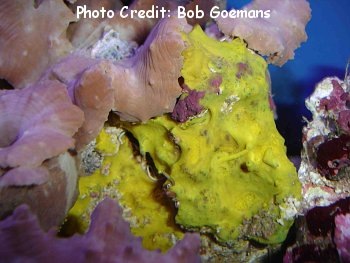
By Bob Goemans


Not Reef Tank Suitable
Not Suitable for Fish-Only Tank
Those that may arrive as hitchhikers on corals or live rock and rarely survive.
FYI - Sponges posses no nervous, digestive or excretory systems, and feed by filtering suspended bacteria and fine detritus. Strong water movement is vital to almost all, not only for carrying food to these sessile creatures but also to carry waste/unused matter away. In fact, a sponge the size of a baseball can filter fifty gallons of water per hour! Most do best only in low light areas and where currents are quite swift.
Each sponge has both female and male reproduction capabilities. Cutting a piece from the healthy tissue and simply relocating it to another area can form new colonies. Bear in mind the new specimen should not be exposed to air during the procedure as that may kill it. New purchases should be bagged under water with no oxygen added or should the bag contain an air space while being transported. They are not too sensitive to temperature changes, yet sudden changes in salinity may have drastic effects.
New specimens should not contain any gray or white tissue, which is generally a sign of dying or dead tissue. However, it is possible to cut that section out, of course under water. Sponges should be placed in shaded areas where water movement is very good and detritus or algae do not accumulate on their surface. They feed upon plankton and suspended detritus, and require numerous feedings per day of live and/or preserved commercial phytoplankton products or that of animal and plant powders that produce suspended products in the bulk water.
Without a doubt, most sponges should remain in the wild, as they are difficult to impossible to maintain in captivity, and/or simply not suited for confinement in closed systems.